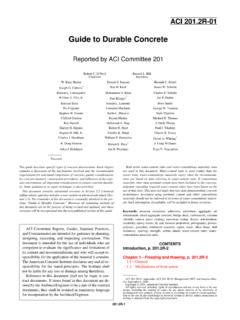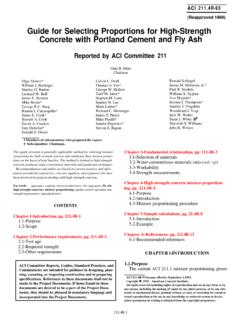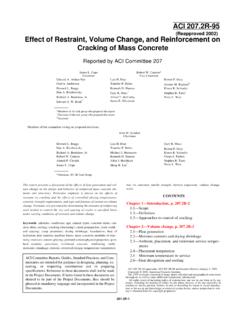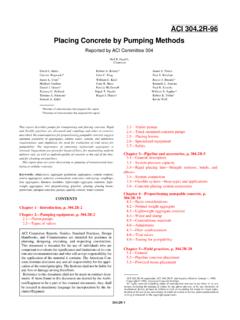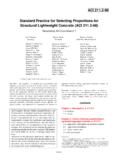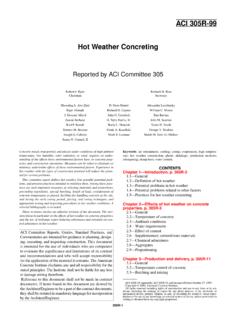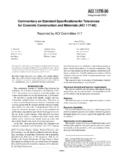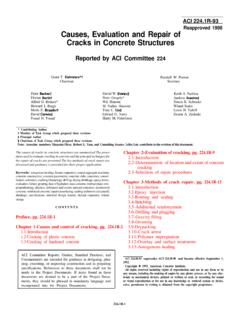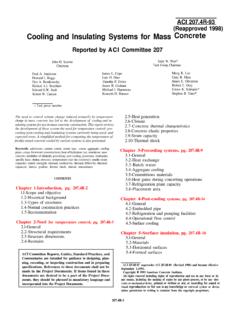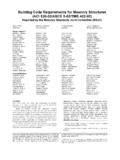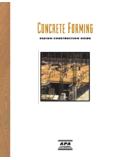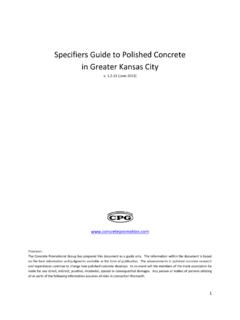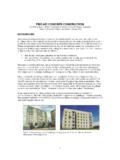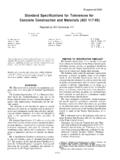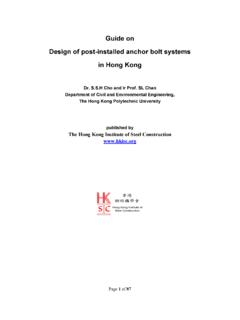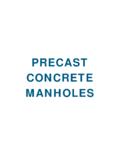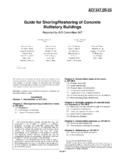Transcription of 347-01 Guide to Formwork for Concrete - bpesol.com
1 ACI 347-01 supersedes ACI 347R-94 (Reapproved 1999) and became effectiveDecember 11, 2001. Copyright 2001, American Concrete rights reserved including rights of reproduction and use in any form or by anymeans, including the making of copies by any photo process, or by electronic ormechanical device, printed, written, or oral, or recording for sound or visual reproduc-tion or for use in any knowledge or retrieval system or device, unless permission inwriting is obtained from the copyright proprietors. ACI Committee Reports, Guides, Standard Practices,and Commentaries are intended for guidance in planning,designing, executing, and inspecting construction. Thisdocument is intended for the use of individuals who arecompetent to evaluate the significance and limitations ofits content and recommendations and who will accept re-sponsibility for the application of the material it American Concrete Institute disclaims any and all re-sponsibility for the stated principles.
2 The Institute shallnot be liable for any loss or damage arising to this document shall not be made in con-tract documents. If items found in this document are de-sired by the Architect/Engineer to be a part of the contractdocuments, they shall be restated in mandatory languagefor incorporation by the Architect/Engineer. 347-1 Guide to Formwork for ConcreteACI 347-01 Objectives of safety, quality, and economy are given priority in these Guide -lines for Formwork . A section on contract documents explains the kind andamount of specification guidance the engineer/architect should provide forthe contractor. The remainder of the report advises the Formwork engineer/contractor on the best ways to meet the specification requirements safelyand economically. Separate chapters deal with design, construction, andmaterials for Formwork . Considerations peculiar to architectural concreteare also outlined in a separate chapter.
3 Other sections are devoted to form-work for bridges, shells, mass Concrete , and underground work. The con-cluding chapter on Formwork for special methods of construction includesslipforming, preplaced aggregate Concrete , tremie Concrete , precast, andprestressed : anchors; architectural Concrete ; coatings; Concrete ; construc-tion; falsework; forms; Formwork ; form ties; foundations; quality control;reshoring; shoring: slipform construction; specifications; , p. 347-2 Chapter 1 Introduction, p. Achieving economy in Contract documentsChapter 2 Design, p. Unit Safety factors for Bracing and Foundations for SettlementChapter 3 Construction, p. Safety Construction practices and Irregularities in formed Shoring and Inspection and adjustment of formworkReported by ACI Committee 347 Randolph H. BordnerKevin D. HeinertRobert G. McCrackenRamon J.
4 CookG. P. Jum Horst John R. Paine, N. Cornell, IIMary K. HurdRussell B. PeckWilliam A. Dortch, S. JohnstonWilliam R. PhillipsJeffrey C. ErsonDov KaminetzkySalvatore V. PizzutoNoel J. GardnerHarry B. Lancelot, IIIW. Thomas ScottSamuel A. GreenbergH. S. LewAviad ShapiraR. Kirk GregoryDonald M. MarksPericles S. StivarosAwad S. HannaDavid W. JohnstonChairmanKevin L. WheelerSecretary347-2 ACI Removal of forms and Shoring and reshoring of multistory structuresChapter 4 Materials, p. Properties of Form coatings and release agentsChapter 5 Architectural Concrete , p. Role of the Materials and Form removalChapter 6 Special structures, p. Bridges and viaducts, including high Structures designed for composite Folded plates, thin shells, and long-span roof Mass Concrete Underground structuresChapter 7 Special methods of construction,p. Preplaced aggregate Permanent Forms for prestressed Concrete Forms for site Use of precast Concrete for Forms for Concrete placed underwaterChapter 8 References, p.
5 Referenced standards and Cited referencesPREFACEB efore the formation of ACI Committee 347 (formerlyACI Committee 622) in 1955, there was an increase in theuse of reinforced Concrete for longer span structures, multi-storied structures, and increased story need for a Formwork standard and an increase inknowledge concerning the behavior of Formwork was evi-dent from the rising number of failures, sometimes resultingin the loss of life. The first report by the committee, based ona survey of current practices in the United States and Canada,was published in the ACI JOURNAL in June * Thesecond committee report was published in the ACI JOURNALin August This second report was an in-depth re-view of test reports and design formulas for determining lat-eral pressure on vertical Formwork . The major result of thisstudy and report was the development of a basic formulaestablishing form pressures to be used in the design of verti-cal first standard was ACI 347-63.
6 Subsequent revisionswere ACI 347-68 and ACI 347-78. Two subsequent revisions(ACI 347R-88 and ACI 347R-94) were presented as a com-mittee report because of changes in the ACI policy on styleand format of standards. This revision returns the Guide tothe standardization major contribution of the committee has been the spon-sorship and review of Formwork for by , first published in 1963 and currently in its sixth edi-tion. Now comprising more than 490 pages, this is the mostcomprehensive and widely used document on this subject(the Japan National Council on Concrete has published aJapanese translation). The paired values stated in inch-pound and SI units areusually not exact equivalents. Therefore each system is tobe used independently of the other. Combining valuesfrom the two systems may result in nonconformance withthis 1 Scope This Guide covers: A listing of information to be included in the contractdocuments; Design criteria for horizontal and vertical forces onformwork; Design considerations, including safety factors, to be usedin determining the capacities of Formwork accessories; Preparation of Formwork drawings; Construction and use of Formwork , including safetyconsiderations; Materials for Formwork ; Formwork for special structures; and Formwork for special methods of Guide is based on the premise that layout, design, andconstruction of Formwork should be the responsibility of theformwork engineer/contractor.
7 This is believed to be fun-damental to the achievement of safety and economy of form-work for Concrete . DefinitionsThe following definitions will be used in this Guide . Manyof the terms can also be found in ACI Shores placed snugly under a Concrete slabor structural member after the original Formwork and shoreshave been removed from a small area at a time, withoutallowing the slab or member to deflect; thus the slab or othermember does not yet support its own weight or existingconstruction loads from Surface air voids: small regular or irregularcavities, usually not exceeding in. (15 mm) in diameter,resulting from entrapment of air bubbles in the surface offormed Concrete during placement and consolidation. Alsocalled Specialized temporary support used in theconstruction of arches, shells, and space structures where the * Those references cited in the Preface are in the reference section of Chapter TO Formwork FOR CONCRETE347-3entire temporary support is lowered (struck or decentered) asa unit to avoid introduction of injurious stresses in any partof the bracing Supplementary Formwork membersdesigned to resist lateral The engineer, architect, engineer-ing firm, architectural firm, or other agency issuing projectplans and specifications for the permanent structure, admin-istering the work under contract forms Large prefabricated, mechanically han-dled sections of Formwork designed for multiple reuse; fre-quently including supporting truss, beam, or shoringassemblies completely unitized.
8 Note: Historically, the termhas been applied to floor forming A temporary structure or mold for the support ofconcrete while it is setting and gaining sufficient strength tobe Total system of support for freshly placedconcrete, including the mold or sheathing that contacts theconcrete as well as all supporting members, hardware, andnecessary engineer/contractor Engineer of the form-work system, contractor, or competent person in-charge of des-ignated aspects of Formwork design and Formwork forms Large assemblies used for forming verti-cal surfaces; also called gang lacing Horizontal bracing members at-tached to shores to reduce their unsupported length, therebyincreasing load capacity and Added shores placed snugly under selectedpanels of a deck forming system before any primary (original)shores are removed. Preshores and the panels they supportremain in place until the remainder of the complete bay hasbeen stripped and backshored, a small area at a Shores placed snugly under a stripped con-crete slab or other structural member after the original formsand shores have been removed from a large area, requiringthe new slab or structural member to deflect and support itsown weight and existing construction loads applied beforeinstallation of the A temporary elevated platform (supported orsuspended) and its supporting structure used for supportingworkers, tools, and materials.
9 Adjustable metal scaffoldingcan be used for shoring in Concrete work, provided its struc-ture has the necessary load-carrying capacity and Vertical or inclined support members designedto carry the weight of the Formwork , Concrete , and construc-tion loads Achieving economy in formworkThe engineer/architect can help overall economy in thestructure by planning so that Formwork costs are cost of Formwork in the United States can be as much as60% of the total cost of the completed Concrete structure inplace and sometimes investment requires careful thought and planning bythe engineer/architect when designing and specifying thestructure and by the Formwork engineer/contractor when de-signing and constructing the drawings, prepared by the Formwork engineer/contractor, can identify potential problems and should giveproject site employees a clear picture of what is required andhow to achieve following guidelines show how the engineer/architectcan plan the structure so that Formwork economy may bestbe achieved:To simplify and permit maximum reuse of Formwork , thedimensions of footings, columns, and beams should be ofstandard material multiples, and the number of sizes shouldbe minimized; When interior columns are the same width as or smallerthan the girders they support, the column form becomesa simple rectangular or square box without boxouts,and the slab form does not have to be cut out at eachcorner of the column; When all beams are made one depth (beams framinginto beams as well as beams framing into columns), thesupporting structures for the beam forms can be carriedon a level platform supported on shores.
10 Considering available sizes of dressed lumber, ply-wood, and other ready-made Formwork components,and keeping beam and joist sizes constant will reducelabor time; The design of the structure should be based on the useof one standard depth wherever possible when commer-cially available forming systems, such as one-way ortwo-way joist systems, are used; The structural design should be prepared simulta-neously with the architectural design so that dimen-sions can be better coordinated. Room sizes can vary afew inches to accommodate the structural design; The engineer/architect should consider architecturalfeatures, depressions, and openings for mechanical orelectrical work when detailing the structural system,with the aim of achieving economy. Variations in thestructural system caused by such items should beshown on the structural plans.
